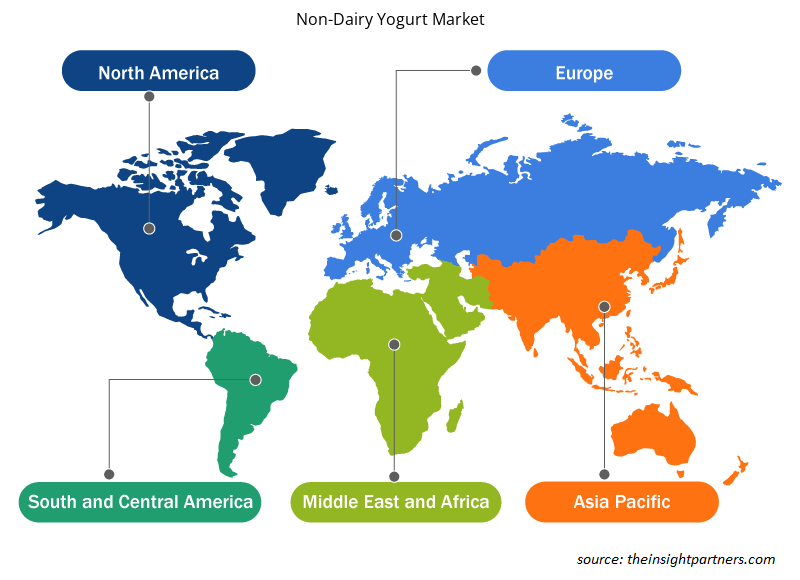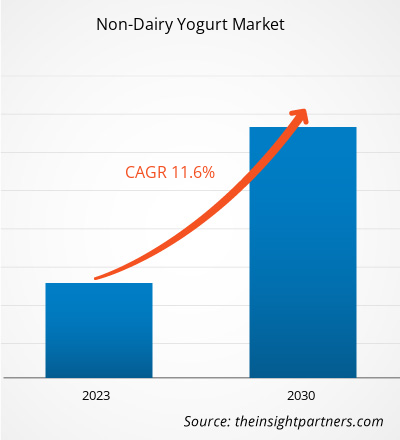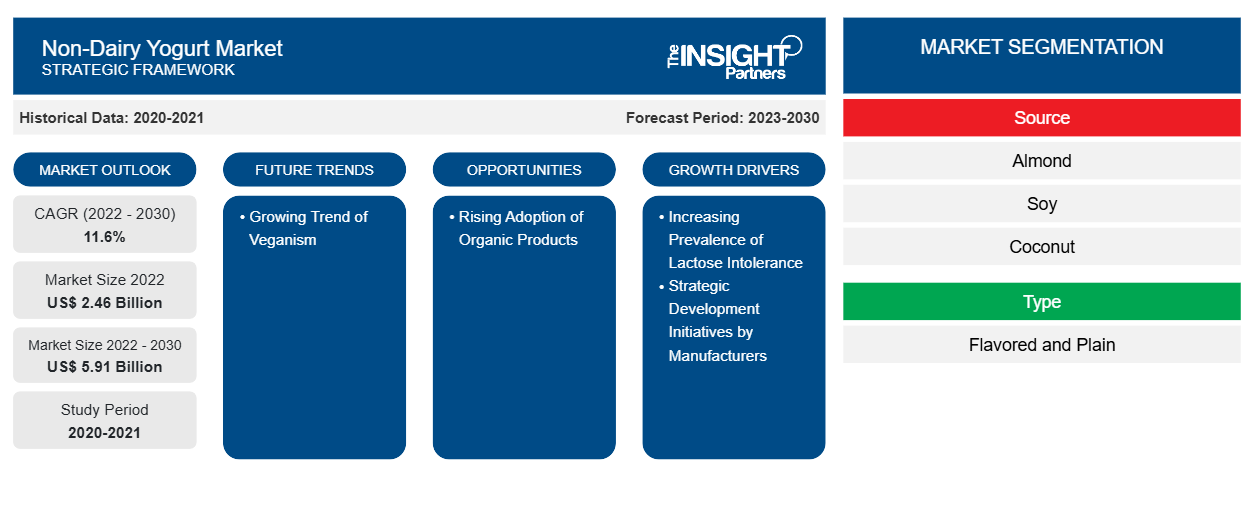[研究报告] 2022年非乳制酸奶市场规模价值为 24.5817 亿美元,预计到 2030 年将达到 59.0801 亿美元;预计 2022 年至 2030 年市场复合年增长率为 11.6%。
市场洞察和分析师观点:
非乳制酸奶是一种不含任何乳制品成分(如牛奶或源自乳制品的酸奶培养物)的酸奶。相反,它通常由植物来源制成,如杏仁奶、椰子奶、大豆奶或腰果奶,并且通常含有活菌培养物,可提供与传统乳制酸奶类似的发酵过程。这使得乳糖不耐症、纯素食者或遵循无乳制品饮食的人可以享受具有相似味道和质地的酸奶类产品。乳糖不耐症的患病率不断上升和素食主义趋势的兴起推动了全球非乳制酸奶市场的增长。
增长动力和挑战:
非乳制酸奶由不含乳糖的杏仁奶、豆奶和椰奶制成。此外,植物基非乳制酸奶的质地、乳脂度和稠度与传统酸奶相似。此外,植物基非乳制酸奶富含蛋白质、钙和其他营养素,可满足消费者日常的营养需求。因此,消费者中乳糖不耐症和牛奶过敏的日益普遍正在推动非乳制酸奶市场的增长。此外,联合国、善待动物组织、优质食品研究所和许多其他组织认为,素食主义可以在拯救地球免受气候危机方面发挥重要作用。消费者对畜牧业对环境不利影响的认识正在提高。植物基乳制品消费量的不断增长有助于最大限度地减少碳足迹,节约水和其他各种自然资源,并减少对环境的整体影响。因此,素食主义的兴起正在推动市场增长。然而,由于原料成本高、生产和营销费用高,非乳制酸奶的成本高于传统酸奶。这一因素可能会阻碍非乳制酸奶市场的增长。
定制此报告以满足您的需求
您可以免费定制任何报告,包括本报告的部分内容、国家级分析、Excel 数据包,以及为初创企业和大学提供优惠和折扣
-
获取此报告的关键市场趋势。这个免费样品将包括数据分析,从市场趋势到估计和预测。
报告细分和范围:
全球非乳制酸奶市场根据来源、类型、性质、分销渠道和地理位置进行分类。根据来源,非乳制酸奶市场细分为大豆、杏仁、椰子、燕麦等。根据类型,市场分为调味酸奶和原味酸奶。就性质而言,市场分为有机酸奶和传统酸奶。根据分销渠道,非乳制酸奶市场分为超市和大卖场、便利店、在线零售和其他。根据地理位置,市场分为北美(加拿大、美国和墨西哥)、欧洲(德国、法国、意大利、英国、俄罗斯和欧洲其他地区)、亚太地区(澳大利亚、中国、日本、印度、韩国和亚太地区其他地区)、南美洲和中美洲(巴西、阿根廷和南美洲和中美洲其他地区)以及中东和非洲(沙特阿拉伯、南非、阿联酋和中东和非洲其他地区)。UAE, and Rest of Middle East & Africa).
节段分析:
根据来源,非乳制酸奶市场分为大豆、杏仁、椰子、燕麦和其他。椰子酸奶占据了相当大的市场份额。随着消费者对更健康的乳制品替代品的偏好日益增加,椰子制品的消费量也在增加。椰子乳制品替代品是天然和有机的,为消费者提供了多种健康益处。例如,椰奶有助于促进心血管健康,其有机性质具有抗炎、抗菌和抗真菌特性。因此,预计所有这些因素都将在预测期内推动椰子市场的繁荣。
区域分析:
根据地理位置,非乳制酸奶市场分为五个主要区域——北美、欧洲、亚太地区、南美和中美以及中东和非洲。2022 年,全球非乳制酸奶市场由欧洲主导;市场价值为 9.226 亿美元。北美是该市场的第二大贡献者,占全球市场的约 20%。预计在预测期内,亚太地区的非乳制酸奶市场的复合年增长率将达到 13.2%。由于消费者生活方式的变化以及清洁标签、有机和无麸质产品的消费增加,亚太地区的非乳制酸奶市场正在显着增长。由于城市化进程加快、饮食多样化以及食品行业外国直接投资合法化,该地区的市场也在经历显着的转变。预计这些因素将在预测期内推动亚太地区对非乳制酸奶的需求。
此外,由于越来越多的人选择更健康的乳制品替代品,北美是非乳制酸奶市场最重要的地区之一。根据克利夫兰诊所的数据,2019 年,36% 的美国人患有乳糖不耐症。这表明北美人更喜欢食用植物性产品,从而加速了对酸奶等非乳制品的需求。随着注重健康的消费者数量不断增加、环境问题日益严重以及植物性饮食趋势日益增长,植物性酸奶在该地区越来越受欢迎。
行业发展和未来机遇:
以下列出了非乳制酸奶市场的主要参与者采取的各种举措:
- 2022 年 3 月,美国公司 AYO Foods LLC 推出了新的植物酸奶系列,开发了多种口味的原味杏仁奶酸奶。
- 2021年2月,Hasla Foods推出了24盎司家庭装零糖燕麦奶酸奶。该产品每份仅含90卡路里,且不添加糖。
- 2021 年 6 月,Hasla Foods 扩大了其零售足迹,将其产品销往美国 160 家 National Grocers by Vitamin Cottage 商店。
- 2020 年 12 月,达能公司推出了 Silk Kids 杏仁奶酸奶替代植物酸奶,专为儿童配制。该产品含有蚕豆蛋白、杏仁奶、活性菌种和有机椰子油。它富含维生素 D 和钙;这满足了儿童的营养需求。
非乳制酸奶
非乳制酸奶市场区域洞察
Insight Partners 的分析师已详尽解释了预测期内影响非乳制酸奶市场的区域趋势和因素。本节还讨论了北美、欧洲、亚太地区、中东和非洲以及南美和中美洲的非乳制酸奶市场细分和地理位置。

- 获取非乳制酸奶市场的区域特定数据
非乳制酸奶市场报告范围
| 报告属性 | 细节 |
|---|---|
| 2022 年市场规模 | 24.6亿美元 |
| 2030 年市场规模 | 59.1亿美元 |
| 全球复合年增长率(2022 - 2030 年) | 11.6% |
| 史料 | 2020-2021 |
| 预测期 | 2023-2030 |
| 涵盖的领域 |
按来源
|
| 覆盖地区和国家 |
北美
|
| 市场领导者和主要公司简介 |
|
非乳制酸奶市场参与者密度:了解其对业务动态的影响
非乳制酸奶市场正在快速增长,这得益于终端用户需求的不断增长,而这些需求又源于消费者偏好的不断变化、技术进步以及对产品优势的认识不断提高等因素。随着需求的增加,企业正在扩大其产品范围,进行创新以满足消费者的需求,并利用新兴趋势,从而进一步推动市场增长。
市场参与者密度是指在特定市场或行业内运营的企业或公司的分布情况。它表明在给定市场空间中,相对于其规模或总市场价值,有多少竞争对手(市场参与者)存在。
在非乳制酸奶市场运营的主要公司有:
- 海恩天体集团
- 达能公司
- 斯普林菲尔德奶油厂
- 抒情食品公司
- COYO 有限公司
免责声明:上面列出的公司没有按照任何特定顺序排列。

- 获取非乳制酸奶市场顶级关键参与者概述
COVID-19 影响:
COVID-19 疫情影响了各国几乎所有行业。北美、欧洲、亚太地区 (APAC)、南美和中美 (SAM) 以及中东和非洲 (MEA) 的封锁、旅行限制和企业停工阻碍了多个行业的增长,包括食品和饮料行业。制造部门的关闭扰乱了全球供应链、制造活动、交付计划以及必需品和非必需品销售。2020 年,各家公司的产品交付延迟,产品销售下滑。
在 COVID-19 疫情期间,消费者的饮食偏好发生了重大变化,许多消费者转向植物性饮食。由于对健康和保健问题的关注度增加,对乳制品替代品的需求在疫情期间大幅增加。因此,由于健康意识的提高,疫情期间对非乳制酸奶的需求激增。然而,由于制造部门仍然关闭,产量不足导致需求和供应方之间出现缺口。产品库存高的制造商满足了不断增长的需求;然而,小型和中型制造商缺乏产品库存,从而造成财务损失。这些因素对非乳制酸奶市场规模产生了负面影响。
2021年,随着多个政府宣布放宽先前实施的限制措施,各经济体纷纷恢复运营,这对全球市场产生了积极影响。此外,制造商获准满负荷生产,这有助于他们弥补供需缺口。
竞争格局和重点公司:
全球非乳制酸奶市场的主要参与者包括Hain Celestial Group Inc、Danone Sa、Springfield Creamery Inc、Lyrical Foods Inc、Coyo Pty Ltd、Valio Ltd、Oatly Group Ab、Daiya Foods Inc、Forager Project LLC 和 Harmless Harvest Inc。这些市场参与者正在采取战略发展举措来扩大规模,进一步推动市场增长。
- 历史分析(2 年)、基准年、预测(7 年)及复合年增长率
- PEST和SWOT分析
- 市场规模、价值/数量 - 全球、区域、国家
- 行业和竞争格局
- Excel 数据集
近期报告
相关报告
客户评价
购买理由
- 明智的决策
- 了解市场动态
- 竞争分析
- 客户洞察
- 市场预测
- 风险规避
- 战略规划
- 投资论证
- 识别新兴市场
- 优化营销策略
- 提升运营效率
- 顺应监管趋势























 获取免费样品 - 非乳制酸奶市场
获取免费样品 - 非乳制酸奶市场